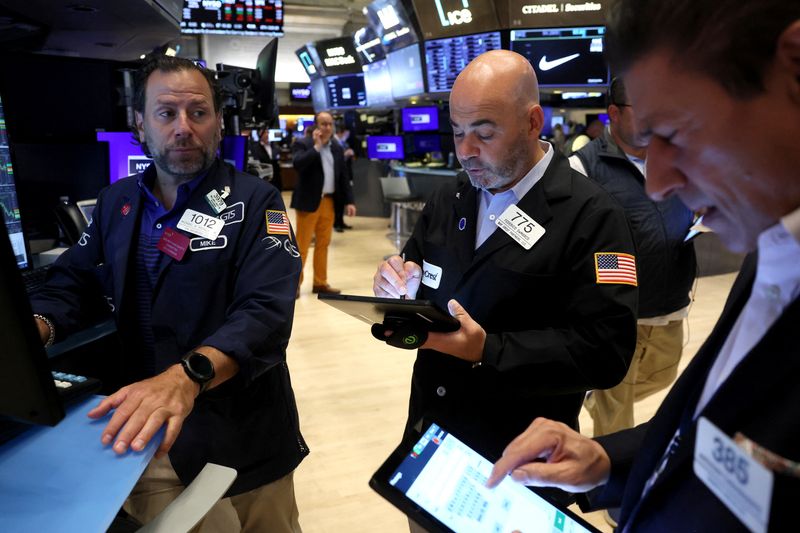By Chuck Mikolajczak
NEW YORK (Reuters) - U.S. stocks kicked off August sharply lower after a round of economic data on Thursday spurred concerns the economy may be slowing faster than anticipated while the Federal Reserve maintains a restrictive monetary policy.
Equities initially opened higher, buoyed in part by gains in Meta Platforms (NASDAQ:META) after its quarterly results topped expectations and the Facebook parent issued an upbeat outlook for the third quarter. Its shares closed 5.87% higher as the biggest boost to the S&P 500.
Early gains, however, evaporated after data showed a measure of manufacturing activity from the Institute for Supply Management (ISM) dropped to an eight-month low in July at 46.8, signifying contraction.
"It raises a genuine fear that the Fed is behind on cutting rates," Lou Basenese, president and chief market strategist at MDB Capital in New York.
"Few investors have confidence in the Fed sticking the proverbial soft landing and now the data is starting to support those concerns."
The Dow Jones Industrial Average fell 494.82 points, or 1.21%, to 40,347.97, the S&P 500 lost 75.62 points, or 1.37%, to 5,446.68 and the Nasdaq Composite lost 405.25 points, or 2.30%, to 17,194.15.
August is typically one of the weakest months of the year for stocks.
Other data showed the number of Americans filing new applications for unemployment benefits increased to an 11-month high last week, suggesting some softening in the labor market, although seasonal factors also played a role.
Investors will eye the government payrolls report on Friday for any signs of further weakness in the labor market.
Both the S&P 500 and Nasdaq registered their biggest daily percentage gains since February in the prior session, boosted by a rally in chip shares after the Fed kept rates steady, as expected.
Defensive sectors such as utilities and real estate led gains, as geopolitical concerns over rising tensions in the Middle East boosted the dollar and pulled Treasury yields lower.
Declines in megacap names such as Apple (NASDAQ:AAPL) , down 1.68%, and Amazon (NASDAQ:AMZN) , which lost 1.56% ahead of their quarterly results due after the closing bell weighed heavily on the tech and consumer discretionary indexes, which were among the worst performing of the 11 major S&P sectors.
After the closing bell, Amazon shares lost 4.47% following its quarterly results and outlook.
Of the 342 companies in the S&P 500 that have reported earnings through Thursday morning, 79.2% have topped analyst expectations, according to LSEG data, slightly above the 79% beat rate over the past four quarters. The estimated earnings growth rate for the quarter is 13.3%, up from 10.6% on July 1.
The small-cap Russell 2000 slumped 3.03% for its biggest daily percentage drop since Feb. 13. Small caps have been volatile recently as investors rotate between cheaper names and more expensive stocks.
"Without a good economy, these economically sensitive small stocks just won’t do anything, even with rate cuts," said Steve Sosnick, market strategist Interactive Brokers (NASDAQ:IBKR), Greenwich, Connecticut.
Nvidia (NASDAQ:NVDA) dropped 6.67% in a broader chip stocks selloff sparked by Arm Holdings (NASDAQ:ARM)' conservative revenue forecast and Qualcomm (NASDAQ:QCOM) flagging a revenue hit from the impact of trade curbs. ARM shares plummeted 15.72% while Qualcomm stumbled 9.37% as the PHLX semiconductor index lost 7.14% for its biggest daily percentage drop since March 2020.
Moderna (NASDAQ:MRNA) plunged 21.01% after cutting its 2024 sales forecast for COVID-19 and respiratory syncytial virus vaccines by up to 25%.
Eli Lilly (NYSE:LLY) rose 3.5% after trial results showed weight-loss drug Zepbound reduces the risk of hospitalization, death and other outcomes for obese adults with a common type of heart failure.
Declining issues outnumbered advancers by a 2.04-to-1 ratio on the NYSE and on the Nasdaq, declining issues outnumbered advancers by a 3.19-to-1 ratio.

The S&P 500 posted 54 new 52-week highs and seven new lows while the Nasdaq Composite recorded 65 new highs and 177 new lows.
Volume on U.S. exchanges was 14.15 billion shares, compared with the 11.71 billion average for the full session over the last 20 trading days.